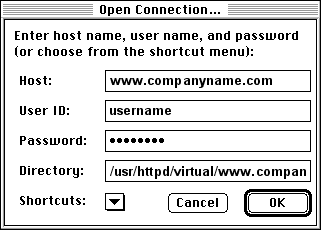Fetch - Macintosh FTP Client
|
More information about Real Time's products & services is available on our sales web site. Direct links for each item are listed below:

|
Fetch is an easy-to-use, full-featured FTP client for the Apple Macintosh.
Table of Contents:
Homepage
The homepage for Fetch is http://fetchsoftworks.com/
Initiate a Connection
When you start Fetch a dialog box automatically opens to create a connection. Use the mouse or the
tab key to move among fields.

- Refer to the Welcome Letter that was faxed to you for the following:
- In the Host: field enter the Main URL for your website
- In the User ID: field, enter your Account name
- In the Password: field, enter your Password (note: Fetch displays this as a series of
dots)
- In the Directory field, enter the directory which contains your html files, for instance /usr/httpd/virtual/www.companyname.com/html
- Click OK
- A connection with the ftp server is established and the session window opens.
File Transfer with Fetch
Once connected, The Fetch window displays file and directory information on the remote computer. To
navigate among directories, double-click on a directory name. To move up in the directory structure, select
a name from the drop-down box.
Upload with Fetch on a Macintosh
- Click on the Put File button.
- A directory box opens. Select the file to upload from your local computer and click Open Note:
Unix treats filenames somewhat differently than other programs. It is useful to remove spaces, capitalization
and extensions from filenames before uploading them
- A second dialog box opens. From the Format drop-down list, select Text if it is a text
file, MacBinary if it is a binary file for use on another Macintosh, or Raw Data if it is
a binary file for use on any other operating system, such as a GIF or JPEG for a Web page
- Click the OK button
Download with Fetch on a Macintosh
- Click once on a file name to select it
- The default file type setting is Automatic; this usually works fine. If necessary, click Text
to specify a text file, or Binary to specify a binary file
- Click on the Get File button
- A directory box opens. Select a directory in which to store the file and click Save
Close a Connection
- To close the connection, click the Close Connection button.
- To open another connection, click the Open Connection button. (The Close Connection
button toggles to Open when you disconnect.)
The instructions and screen shots contained within this website are specific to services offered by Real Time Enterprises only.
If you have any problems connecting to Real Time after carefully following these directions, please call (952) 943-8700 and we will
be happy to help you.
Permission is granted to copy, distribute and/or modify this
document under the terms of the GNU Free Documentation License,
Version 1.1 or any later version published by the Free Software
Foundation; with no Invariant Sections, no Front-Cover Texts and
no Back-Cover Texts. A copy of the license is included in the
section entitled "GNU Free Documentation License".
|
|



